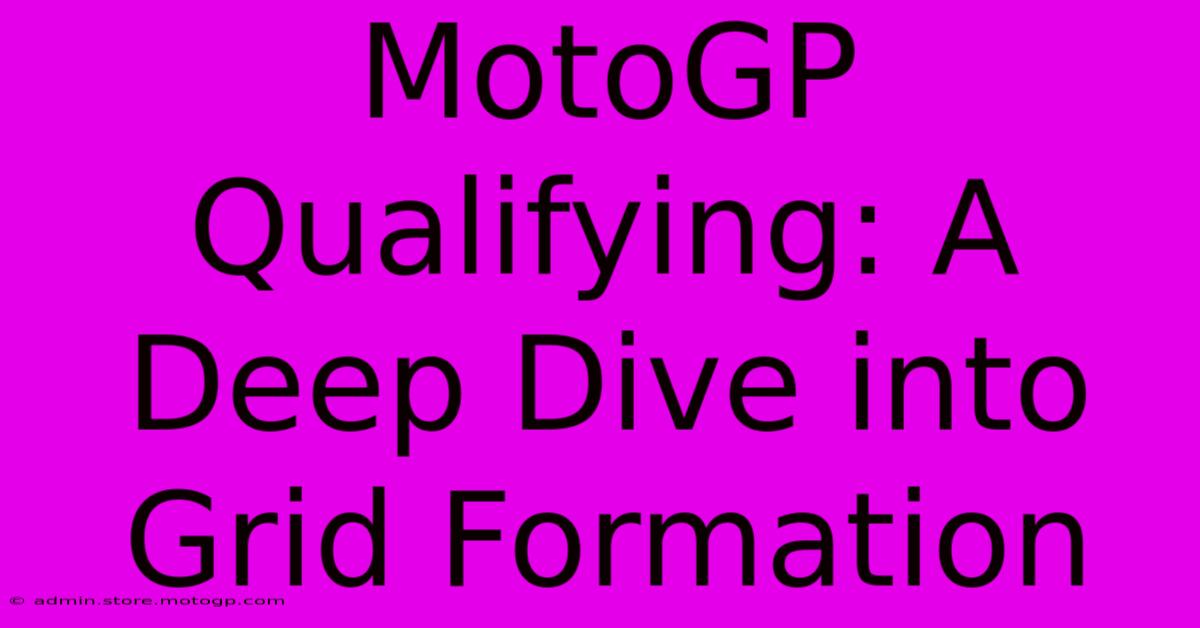MotoGP Qualifying: A Deep Dive Into Grid Formation

Table of Contents
MotoGP Qualifying: A Deep Dive into Grid Formation
MotoGP racing is a spectacle of speed, skill, and strategy. But before the lights go out and the roar of the engines fills the air, there's a crucial phase that determines the starting positions: qualifying. Understanding MotoGP qualifying is key to appreciating the nuances of the race itself. This deep dive explores the intricacies of grid formation in MotoGP.
The Qualifying Format: A Breakdown
The current MotoGP qualifying format is designed to create excitement and accurately reflect rider performance. It unfolds across three sessions:
Q1 (Qualifying 1): The First Cut
The riders who finish positions 11th-20th in the combined Free Practice times (FP1, FP2, FP3) automatically qualify for Q1. This session is a high-stakes battle for survival. Only the two fastest riders progress to Q2, leaving the rest to start from positions 13th to 20th on the grid. Strategy plays a crucial role here; some teams may elect to save their best tires for Q2.
Q2 (Qualifying 2): The Fight for Pole Position
The top ten riders from the combined Free Practice sessions automatically advance to Q2. Joining them are the two fastest riders from Q1. This 12-rider session is intense, a relentless pursuit of the coveted pole position. Tire management and track conditions become even more critical here, as riders attempt to extract maximum performance from their machines. The rider who posts the fastest lap time secures pole position, with the remaining riders filling the rest of the top twelve grid spots.
The Impact of Qualifying
The starting grid significantly impacts the race outcome. Securing a front-row position (pole, second, or third) provides a massive advantage, allowing riders to control the race pace and avoid the chaotic first few corners. Starting further back means a more challenging race, demanding greater overtaking skills and strategic decision-making.
Factors Influencing Qualifying Performance
Several factors contribute to a rider's qualifying performance:
- Rider Skill: Ultimately, the rider's skill and ability to push the bike to its limit under pressure are paramount.
- Bike Setup: Precise tuning of the motorcycle's suspension, electronics, and aerodynamics plays a vital role in lap time. The teams have a limited number of tires for use in qualifying which impacts the number of laps possible to obtain the perfect setup.
- Track Conditions: Weather conditions, such as temperature and humidity, heavily influence grip and tire performance. A wet track demands completely different setup and riding styles than a dry one.
- Tire Choice: Selecting the appropriate tire compound for the qualifying session is critical. Soft compound tires provide faster lap times, but they also degrade more quickly. This calculation is a delicate balancing act.
- Team Strategy: The team's strategy, including tire allocation and setup adjustments, profoundly impacts the rider's performance. The team mechanics play a vital role in obtaining optimum performance.
Beyond the Qualifying Session: Long Game Strategies
Qualifying isn’t just about the fastest lap; it's about laying the foundation for the race. Teams analyze the data from qualifying to inform their race strategy, including tire selection, fuel management, and race pace. It's a continuous process of optimization.
Conclusion: The Importance of MotoGP Qualifying
MotoGP qualifying is more than just a time trial; it's a critical stage that sets the scene for the Grand Prix. Understanding the intricacies of the qualifying format, the factors that influence performance, and the strategic considerations involved offers a deeper appreciation of the intense competition and skill required to succeed in MotoGP. The battle for pole position is a captivating microcosm of the larger race, highlighting the precision, skill, and teamwork that defines this thrilling motorsport.

Thank you for visiting our website wich cover about MotoGP Qualifying: A Deep Dive Into Grid Formation. We hope the information provided has been useful to you. Feel free to contact us if you have any questions or need further assistance. See you next time and dont miss to bookmark.
Featured Posts
-
Moto Gp Get Your Sprint Race Fix
Feb 19, 2025
-
Austin Gp 2025 Economic Benefits
Feb 19, 2025
-
Gp Results How To Interpret And Act
Feb 19, 2025
-
Yamaha V4 Engine The Ultimate Marine Powerhouse
Feb 19, 2025
-
The Power Of Moto Gp Tnt Sports Schedule
Feb 19, 2025
